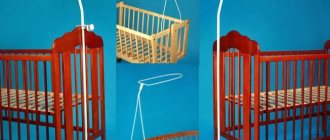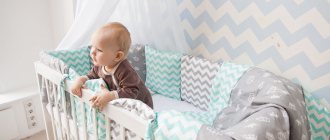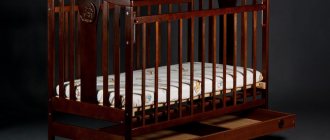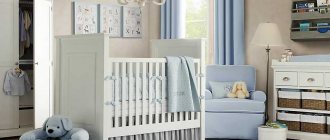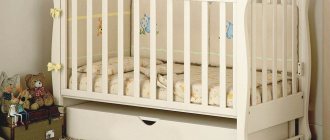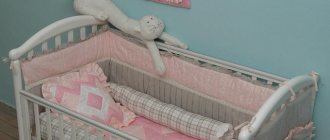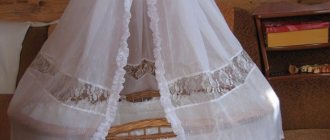A little history
The canopy was invented in the East to protect from the sun. The rulers, when moving through the hot streets, hid behind folds of fabric to protect them from views and hot rays. Later, beds began to be covered with lightweight materials to protect themselves from insects. Arriving in Europe, the canopy somewhat changed its original purpose.
They still protected against insects, but dense fabrics retained a person’s warmth in a confined space, and in cold rooms they served as protection from piercing drafts. In Russia, a canopy was placed over baby cradles to hide babies from the unkind eyes of others and to protect them from the cold and insects.
Why is it needed?
Modern canopies have lost most of their protective functions. Delicate, light, openwork fabrics over cribs are largely decorative and make the room especially cute and cozy.
According to tradition, it is believed that the canopy performs the following functions:
- protects the baby from light and drafts;
- prevents the penetration of insects;
- protects from dust and noise.
In modern housing, most problems are solved in other ways. Well-fitted plastic frames protect against drafts and dust; window nets and mosquito repellents protect against insects. Nowadays, no one seriously puts a canopy on a baby's crib to protect the baby from mosquitoes.
A canopy is a touching and gentle way to create a cozy nest for your little one, where he will sleep sweetly in complete privacy, but will remain visible through a thin veil.
A curtain made of thick fabrics will create darkness during daytime sleep, separate you from others, and help create an individual comfort zone. For many children, a canopy helps them get accustomed to a routine; closed curtains interrupt communication with the outside world and teach them to fall asleep at a certain time.
When using a barrier for babies in cribs, we must not forget about the negative features of canopies:
- stale air inside the crib when using dense fabric, impaired circulation and ventilation;
- accumulation of dust on the material;
- A mobile child can become entangled in the fabric and fall over the unreliable structure.
See also
Rules and best methods for ironing curtains after washing
In small children's rooms, a canopy of any shape takes up space and makes the room overloaded.
Important: the canopy actually holds and accumulates dirt. You need to wash the fabric regularly so that the baby does not swallow dust every time the material moves.
Location options
Crib canopies vary in shape, size and appearance. Their configuration depends on the location where the fabric is attached and its decorative properties. There are several options for placing canopies over cribs.
In the middle
A boy's version is considered to be a canopy attached to a support in the middle of the long side of the bed. The fabric takes on the appearance of a sharp, flat roof of a small house.
At the head of the bed
The location of the fastening on the narrow part of the bed, on the side of the child’s head, is considered an option for girls. If you attach the holder in this way, the fabric covers only part of the crib and the upper part of the body - the canopy looks like a large crown over the princess's head.
Along the perimeter
You can create the perfect canopy over your bed by placing a fabric frame around the perimeter of the crib. The structure is attached to the floor, ceiling or the bed itself. The result is an isolated sleeping area with a ceiling - a small room the size of a bed. This option is used for children of any gender and for adults’ bedrooms and is called royal.
How to care for a canopy
Mothers who care about the health of their babies know that they need to care for the canopy as carefully and regularly as they do for bed linen. That is, the product definitely needs regular washing and ironing.
Canopy manufacturers often make products from translucent fabrics. As a rule, these include tulle and organza. This is due, first of all, to the fact that the material is resistant to wear and easy washing. In addition, it dries quickly. The most difficult things to care for are items made from chintz and models with a large number of ruffles. The fact is that if they are washed frequently, they instantly lose their appearance.
Therefore, ridding the product of dirt will not be difficult. Every housewife knows that to preserve the health of the child, and all family members, you need to keep bed linen, canopy, as well as clothes and toys in a clean condition. In this regard, the canopy needs to be washed well, rinsed thoroughly and dried properly.
Ironing of products deserves special attention, which is carried out in accordance with the instructions indicated on the manufacturer's tag. Usually a cloth made of natural cotton is placed between the fabric and the surface of the iron, which prevents its damage and the occurrence of burns and holes.
Fastening methods. Instructions
To create a canopy with your own hands, you need a holder and fabric for the canopy. The type of finished product depends on the method and location of the rack or frame. There are two types of holder:
- Mobile – moves with the crib, as it is attached to it. Most cribs are made on wheels; parents, if necessary, change the position of the child in the room, move his bed to another place along with the canopy.
- Stationary – attached to the wall or ceiling. When moving the crib, you will not be able to use the canopy.
Stationary and mobile versions of the holder have different mounting locations.
On the side wall
Some crib models are sold with holes for attaching canopies. They are usually made in the middle of the long side. You just need to secure the rod by screwing it tightly. Then attach the loop (fabric holder) by adjusting the height.
On the past
When fastening it to a frame (back, fence), the bar is first fixed with special screws, and the holder is put on. The fabric is hung using loops or Velcro, after which the folds are straightened.
At the head of the crib
The canopies at the headboard are decorative in nature; it will not be possible to completely cover the baby with fabric with this type of fastening. The rod is screwed with fasteners, and the holder is placed at the desired height. All that remains is to put on the decorative openwork fabric.
See also
How to remove scratches from a mirror with your own hands and the subtleties of restoration at home
To the wall of the room itself
Decorative holders made by designers and used for decoration are usually attached to the wall. They are made in the shape of a crown, rectangular or oval. Fixed on the selected wall using dowels and screws. Before putting the fabric on the loop, make sure that the design is reliable. Using fabric in this way, you can completely hide the child.
On the floor
Floor structures have a wide leg that securely holds the loop with fabric at the desired height. All elements are twisted and inserted into the floor base. If necessary, you can quickly change the installation location.
On the ceiling
It is important to choose the most convenient place for the crib, since if the location is changed, the ceiling will have to be drilled again. You cannot attach a bracket to a suspended ceiling. The holder is attached to the ceiling with self-tapping screws. Then you need to gather the fabric into a loop and hang it on an attached ceiling hook or string it on a special cornice and straighten out the folds.
Types of fasteners for canopies
Lightweight fabric is fixed using holders. The appropriate type of fastening depends on the future location of the crib.
Stationary
In this case, the holder can be attached to a wall or ceiling. The downside is that you cannot change the location of the canopy if necessary. This means the crib will also be static. When such fastening is removed, traces will remain that will have to be masked.
Mobile
The most convenient holder option. It is a tall tripod with a ring and several support elements. You can change its position and height.
On a stand
A variation of the previous fastener. The kit includes a floor stand that can be easily removed and moved as needed. You can place it at a comfortable distance from the child.
Designer decoration options
A crib canopy can become the main decoration of a child's room. Decorative elements are used to decorate the canvas and fabric holders. While expecting a baby, parents often create real masterpieces by coming up with their own solution or using ready-made models.
Forged Products
The basis for stationary holders can be forged products that are attached to the ceiling or wall. Such products are offered by departments for decorating children's rooms and workshops that make custom-made forged parts.
The main difficulty is that the holder will be heavy, it must be combined with other elements of the room’s decor - furniture handles, curtain rods.
Wide stripes or loops
You can place openwork or dense fabric on wide stripes or loops, making them the main decor of the canopy. Pink for girls, blue for boys, gold or orange-yellow stripes will decorate any fabric.
Eyelets
By choosing eyelets to fasten the material, you can add an element of decorativeness and shine. Rhinestones, carvings, matte or shiny surface of the rings will enliven the children's room.
Corrugated braid
The corrugated braid completely hides the holder and is convenient for homemade models made of material (wire, hoop) that is not decorative. The cords sewn inside help create a lush canopy by collecting many small folds evenly spaced throughout the loop. Such lushness and uniformity are difficult to achieve in other ways.
Ribbons
Variegated bright ribbons will decorate a girl’s room. With their help, you can tie the fabric to a loop, securing it with a lush bow. To prevent the bow from accidentally coming undone during use, the knot is stitched.
How to sew
To work you will need:
- The main fabric is about 4 meters with a standard roll width (1.5 meters). The amount of fabric depends on how many pleats you want to make, its composition, density, softness and drape. Typically, the more drapery, the more beautiful the result will be.
- Tape for finishing edges, matching the tone of the main fabric, 6 meters.
- Wider ribbon to decorate the top.
- Ready canopy holder.
- Decorations - bows, ruffles, ribbon roses.
- Sewing machine, thread, scissors.
Sewing
- You can take the simplest pattern for a canopy from the Internet, or make it yourself.
- Two parts are cut out of the fabric in a mirror image (to do this, you need to fold the piece in half “face to face”). You can sew a whole canopy, then you won’t need a pattern at all.
- The bottom and side edges are processed, then a ribbon (the thinner one) is basted and attached to them.
- The top is folded 5-10 cm and stitched; a wide ribbon is sewn at a distance of 5 cm from the edge of the main fabric so that the canopy holder can be threaded freely between the seams.
- The junction of the two halves is decorated with a bow, ruffles, and flowers.
- You can also sew any decorations onto the main fabric.
Rules and criteria for choosing fasteners
The main requirements for fasteners are reliability and ease of use. The baby's crib is often moved, moving it closer to the parents at night. At first, the baby often lives in the adult’s bedroom, but later is transferred to his own room. Mobile fastenings are more practical; the canopy is not tied to one place and moves with the crib.
It is important that the mobile structure is strong and holds the curtain well; the fasteners are regularly checked and tightened.
The size of the fabric is chosen so that it does not drag on the floor, does not get tangled in the wheels, but covers the baby below the mattress. For large children's rooms, you can choose stationary holders. Designer mounts on the ceiling or wall, a curtain combined with tulle or curtains will decorate the room. Such designs are used even when the child leaves infancy.
See also
Instructions on how to install grommets with your own hands at home
Making a holder yourself
Ready-made canopy holders cost from 500 rubles, they are sold with fasteners. Material: metal, durable plastic. Creative parents are able to make a bracket and sew a curtain with their own hands. This will brighten up the baby’s anticipation and will allow you to create an exclusive option, unlike common models.
Required:
- pipe made of metal or polymer material;
- loop for fastening fabric;
- material for the curtain - according to individual preferences;
- decorative elements - ribbons, loops, eyelets.
To sew a curtain you need a sewing machine, good threads and a pattern.
Reference: the canopy is suspended at a height of more than a meter above the crib. Otherwise, leaning towards the baby is inconvenient; the child’s personal space is limited.
From the hoop
Ordinary embroidery hoops are used as fastenings for fabric. The larger the diameter, the better the fabric will cover the entire crib. This option is the simplest - the hoop is separated, one half is placed in the center of the sewn openwork fabric, and fastened with the second part.
The structure is then hung on a holder. It is convenient to put fabric with a drawstring on a detachable hoop. Another option for a ready-made round holder can be a hula hoop (gymnastic hoop).
Homemade wire circle
Using stiff wire, the shape and size of the loop can be chosen as desired. The wire is taken with a large cross-section, dense, so that the hanging fabric does not deform the structure. It is important to carefully seal the ends of the frame so that they do not tear the material or cause injury if accidentally touched.
Metal tube
The leg of the canopy is made from a pipe, having first bent it and given the shape of the letter G. The size of the horizontal bend is chosen so that the loop with the fabric hangs above the center of the crib. The pipe is fixed with fasteners to the base of the crib, preferably in 2 places, with a distance of 10-15 centimeters, so that the fasteners clearly fix the vertical position of the rod. A white plastic pipe is lighter and more suitable for a delicate baby bed than metal.
When choosing the shape and fastening of canopies, they are guided by the characteristics of the children's room and the need to move the crib around the apartment. If parents are not sure about the need for this device, it is better not to damage the walls or ceiling, but to use a mobile option - floor-mounted or attached to the crib. Openwork, delicate canopies create coziness in children's rooms and give the room a special charm.
Decoding the icons on clothes Test for cleanliness in your home Laundry weight calculator Ask a question to an expert
Share link:
Ways to place a canopy on a crib
Depending on how the crib is installed in relation to the wall, choose the method of arranging the decorative canopy.
If the bed is located along the wall, the mount is installed in the center of the long side of the crib on the wall side. This canopy has the appearance of a spacious flowing canopy. If necessary, they can completely cover the sleeping area.
Here are some more ways to place a crib:
- when placing the bed longitudinally, it is convenient to use a structure fixed around the perimeter in the form of walls and ceiling;
- when the children's bed is facing the wall, it would be logical to install a canopy at the head.
It happens that the cradle of a newborn is in the middle of the room. In this case, it is possible to strengthen the canopy on the ceiling in the form of a tent.
Advice! The canopy holder is used as a basis for attaching hanging toys.
